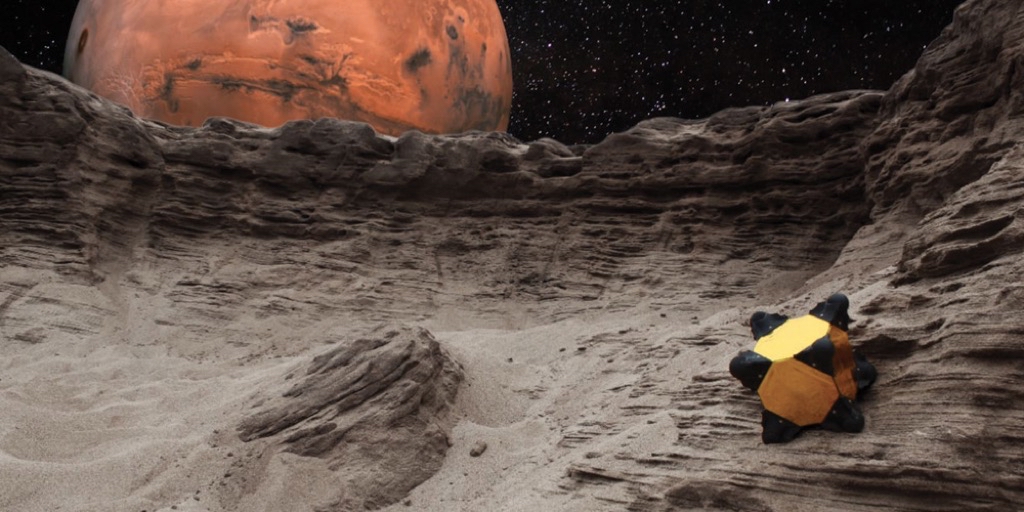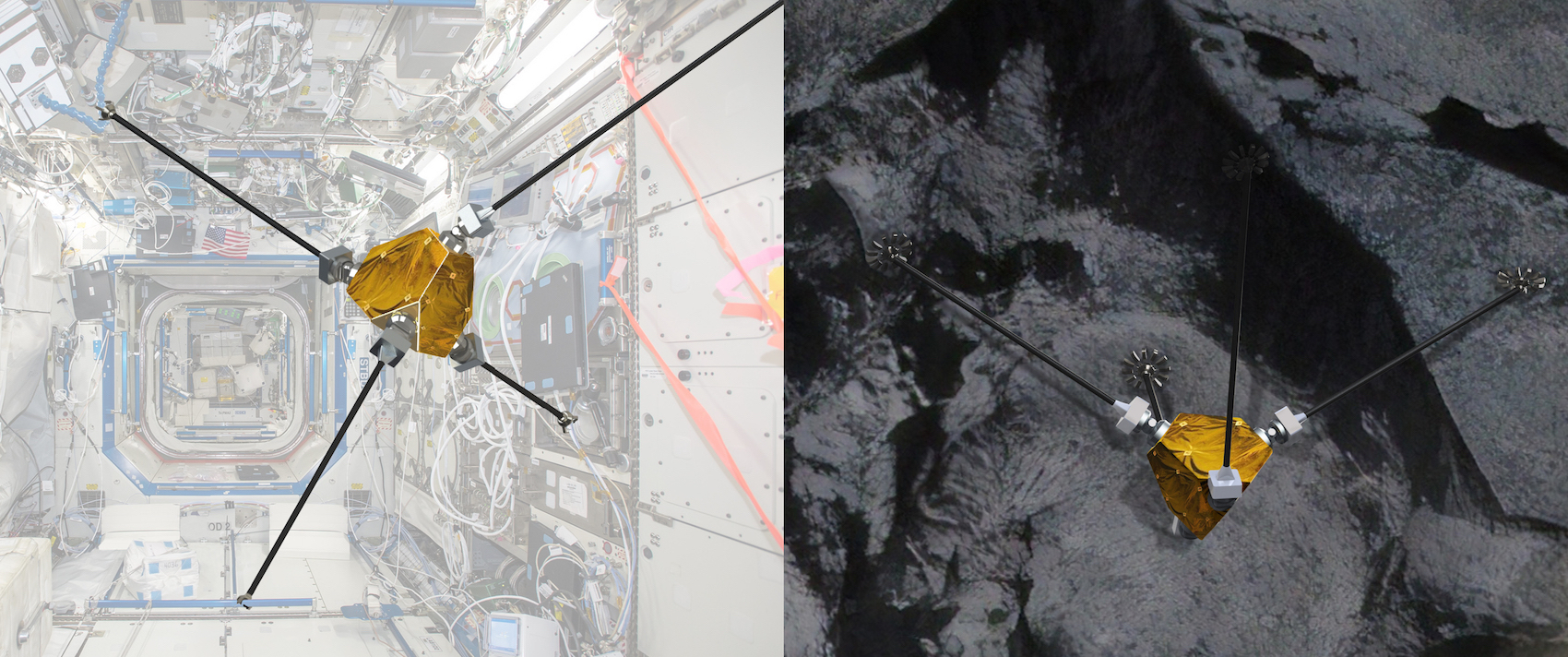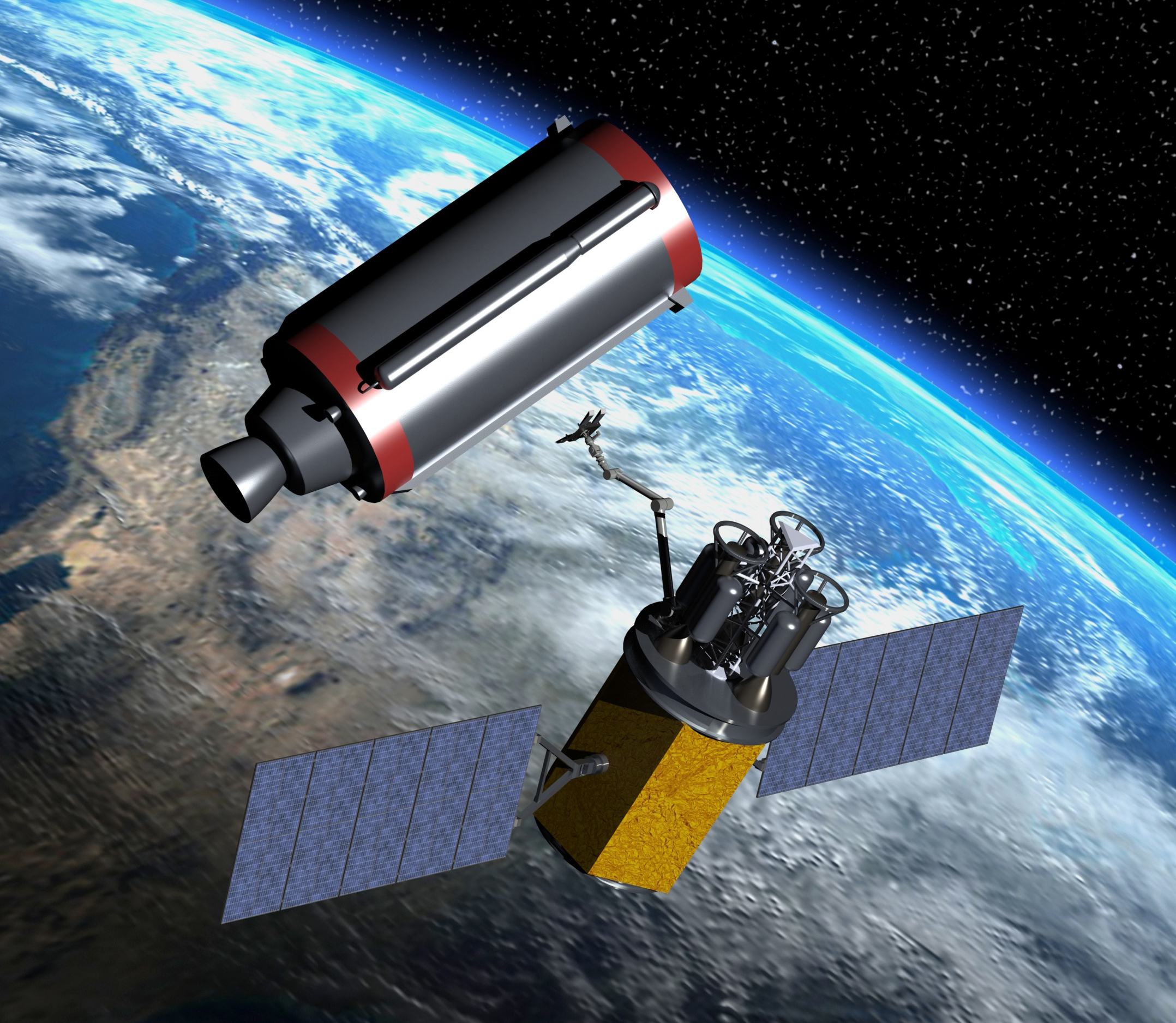
Unconventional Space Robotics
Research Question
What will new space robotic systems look like?
Summary
Space as a frontier is bursting with unique challenges and opportunities, for mankind and especially for roboticists. Novel technologies are required to engage the harsh realities of space and further space science, exploration, and development. Among other projects, the lab focuses on: (1) small assistive free-flying robots, such as the Astrobee robots soon to be operational on the International Space Station, (2) space robot manipulator systems, for on-orbit tasks such as satellite servicing and debris removal, (3) hopping rovers (e.g. Hedgehog) for efficient mobility on small Solar System bodies with extremely low gravity, such as asteroids and comets, (4) gecko-inspired adhesive grippers, a novel space-qualified technology for grasping surfaces, enabling robust capture and manipulation even of large, tumbling objects, (5) multi-agent, modular robots for collaborative, multi-modal mobility (e.g., flying, swimming, rolling) on bodies such as Titan having an atmosphere.

Related Works
-
S. Schneider, A. Bylard, T. G. Chen, P. Wang, M. R. Cutkosky, and M. Pavone, “ReachBot: A Small Robot for Large Mobile Manipulation Tasks,” in IEEE Aerospace Conference, 2022. (In Press)
Abstract:
@inproceedings{SchneiderBylardEtAl2022, author = {Schneider, S. and Bylard, A. and Chen, T. G. and Wang, P. and Cutkosky, M. R. and Pavone, M.}, title = {{ReachBot:} {A} Small Robot for Large Mobile Manipulation Tasks}, booktitle = {{IEEE Aerospace Conference}}, year = {2022}, note = {In press}, asl_abstract = {Robots are widely deployed in space environments because of their versatility and robustness. However, adverse gravity conditions and challenging terrain geometry expose the limitations of traditional robot designs, which are often forced to sacrifice one of mobility or manipulation capabilities to attain the other. Prospective climbing operations in these environments reveals a need for small, compact robots capable of versatile mobility and manipulation. We propose a novel robotic concept called ReachBot that fills this need by combining two existing technologies: extendable booms and mobile manipulation. ReachBot leverages the reach and tensile strength of extendable booms to achieve an outsized reachable workspace and wrench capability. Through their lightweight, compactable structure, these booms also reduce mass and complexity compared to traditional rigid-link articulated-arm designs. Using these advantages, ReachBot excels in mobile manipulation missions in low gravity or that require climbing, particularly when anchor points are sparse. After introducing the ReachBot concept, we discuss modeling approaches and strategies for increasing stability and robustness. We then develop a 2D analytical model for ReachBot’s dynamics inspired by grasp models for dexterous manipulators. Next, we introduce a waypoint-tracking controller for a planar ReachBot in microgravity. Our simulation results demonstrate the controller’s robustness to disturbances and modeling error. Finally, we briefly discuss next steps that build on these initially promising results to realize the full potential of ReachBot.}, asl_address = {Big Sky, Montana}, asl_month = mar, asl_url = {https://arxiv.org/abs/2110.10829}, keywords = {press}, owner = {schneids}, timestamp = {2021-11-04} } -
A. Bylard, R. MacPherson, B. Hockman, M. R. Cutkosky, and M. Pavone, “Robust Capture and Deorbit of Rocket Body Debris Using Controllable Dry Adhesion,” in IEEE Aerospace Conference, Big Sky, Montana, 2017.
Abstract: Removing large orbital debris in a safe, robust, and cost-effective manner is a long-standing challenge, having serious implications for LEO satellite safety and access to space. Many studies have focused on the deorbit of spent rocket bodies (R/Bs) as an achievable and high-priority first step. However, major difficulties arise from the R/Bs’ residual tumble and lack of traditional docking/grasping fixtures. Previously investigated docking strategies often require complex and risky approach maneuvers or have a high chance of producing additional debris. To address this challenge, this paper investigates the use of controllable dry adhesives (CDAs), also known as gecko-inspired adhesives, as an alternative approach to R/B docking and deorbiting. CDAs are gathering interest for in-space grasping and manipulation due to their ability to controllably attach to and detach from any smooth, clean surface, including flat and curved surfaces. Such capability significantly expands the number and types of potential docking locations on a target. CDAs are also inexpensive, are space-qualified (performing well in a vacuum, in extreme temperatures, and under radiation), and can attach and detach while applying minimal force to a target surface, all important considerations for space deployment. In this paper, we investigate a notional strategy for initial capture and stabilization of a R/B having multi-axis tumble, exploiting the unique properties of CDA grippers to reduce maneuver complexity, and we propose alternatives for rigidly attaching deorbiting kits to a R/B. Simulations based on experimentally verified models of CDA grippers show that these approaches show promise as robust alternatives to previously explored methods.
@inproceedings{BylardMacPhersonEtAl2017, author = {Bylard, A. and MacPherson, R. and Hockman, B. and Cutkosky, M. R. and Pavone, M.}, title = {Robust Capture and Deorbit of Rocket Body Debris Using Controllable Dry Adhesion}, booktitle = {{IEEE Aerospace Conference}}, year = {2017}, address = {Big Sky, Montana}, month = mar, url = {/wp-content/papercite-data/pdf/Bylard.MacPherson.Hockman.ea.AeroConf17.pdf}, owner = {bylard}, timestamp = {2017-03-07} } -
B. Hockman, A. Frick, I. A. D. Nesnas, and M. Pavone, “Design, Control, and Experimentation of Internally-Actuated Rovers for the Exploration of Low-Gravity Planetary Bodies,” Journal of Field Robotics, vol. 34, no. 1, pp. 5–24, 2016.
Abstract: In this paper we discuss the design, control, and experimentation of internally-actuated rovers for the exploration of low-gravity (micro-g to milli-g) planetary bodies, such as asteroids, comets, or small moons. The actuation of the rover relies on spinning three internal flywheels, which allows all subsystems to be packaged in one sealed enclosure and enables the platform to be minimalistic, thereby reducing its cost. By controlling flywheels’ spin rate, the rover is capable of achieving large surface coverage by attitude-controlled hops, fine mobility by tumbling, and coarse instrument pointing by changing orientation relative to the ground. We discuss the dynamics of such rovers, their control, and key design features (e.g., flywheel design and orientation, geometry of external spikes, and system engineering aspects). We then discuss the design and control of a first-of-a-kind test bed, which allows the accurate emulation of a microgravity environment for mobility experiments and consists of a 3 DoF gimbal attached to an actively controlled gantry crane. Finally, we present experimental results on the test bed that provide key insights for control and validate the theoretical analysis.
@article{HockmanFrickEtAl2016, author = {Hockman, B. and Frick, A. and Nesnas, I. A. D. and Pavone, M.}, title = {Design, Control, and Experimentation of Internally-Actuated Rovers for the Exploration of Low-Gravity Planetary Bodies}, journal = {{Journal of Field Robotics}}, volume = {34}, number = {1}, pages = {5--24}, year = {2016}, doi = {10.1002/rob.21656}, url = {/wp-content/papercite-data/pdf/Hockman.Pavone.ea.JFR15.pdf}, owner = {bylard}, timestamp = {2017-08-11} }